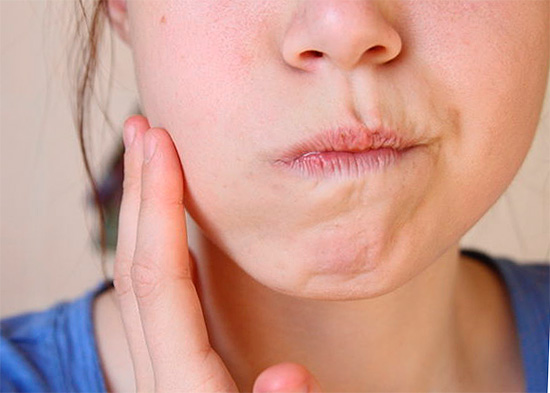
Next you will find out:
- What should rinse a bad tooth in order to get rid of a toothache as quickly as possible;
- What is the mechanism of pain relief during rinsing of the mouth and how it is implemented in practice;
- Important rules of effective rinsing, which will allow to obtain a positive effect and at the same time do not harm your health;
- And what kind of solutions and decoctions can and can not be used for rinsing the mouth with a toothache.
Often a toothache appears at the most inappropriate time - for example, during holidays or on a trip, when immediately contacting a dentist for help can be very problematic. And, perhaps, the first thing a person does in such a situation is trying to rinse a sick tooth in the hope of getting rid of unpleasant sensations as soon as possible (the second common approach is to take pills for toothache, although often both variants are actively combined).
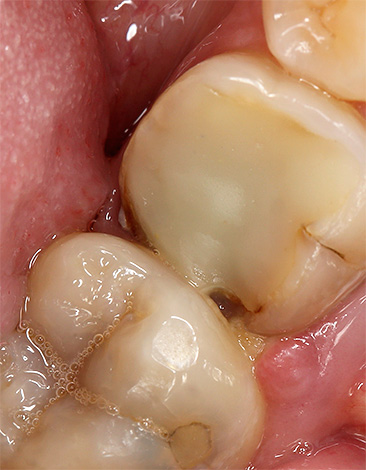
First of all, it is worth noting that rinsing the mouth in some cases really can significantly alleviate the toothache, if you approach the procedure correctly. However, as practice shows, when a person suffers from severe toothache, often far from the most innocuous rinse options are used - they rinse their mouths literally with anything: alcohol, vodka, hydrogen peroxide, a strong solution of potassium permanganate, and even gasoline. Needless to say, without understanding the principles of pain relief by rinsing a sick tooth, a person has every chance to do more harm than to get the benefits.
Therefore, let's see what is the need to properly rinse your mouth to relieve toothache, in order to really noticeably reduce its intensity and at the same time not harm yourself.
It is interesting
The first mentions of the benefits of rinsing the mouth are found in Chinese and Ayurvedic medicine in almost 3000 BC. Later, Hippocrates wrote about the use of a mixture of vinegar, alum and salt for the treatment of gums.
Today, a large number of special mouth rinses are used, including those used to treat stomatitis, oral ulcers, gingivitis, as well as prescribed after some dental procedures.

To begin with, it should be borne in mind that the teeth may hurt for various reasons, and if to put it simply, the most common reasons are as follows:
- Caries has destroyed part of the tooth, and now the nerve endings present in the dentin react to various stimuli that enter the carious cavity (residues of acidic, sweet, spicy foods, etc.);
- Either the bacteria reached the pulp chamber of the tooth and caused inflammation of the so-called dental “nerve” - the pulp. Here, in the closed space of the pulp chamber, the neurovascular bundle swells, is compressed by serous or purulent exudate, which provokes severe pain when a person literally does not find a place for himself. In the future, pulpitis can develop into periodontitis - at this stage the cheek may already be from a good third of the face, often the temperature rises;
- The teeth can also ache (whine) due to thinning or damage to the enamel - for example, after a room whitening procedure, or due to the long-term use of whitening toothpaste, after taking acidic foods, etc.
Sometimes a person may feel that his teeth hurt, but in fact the problem is in the gums.
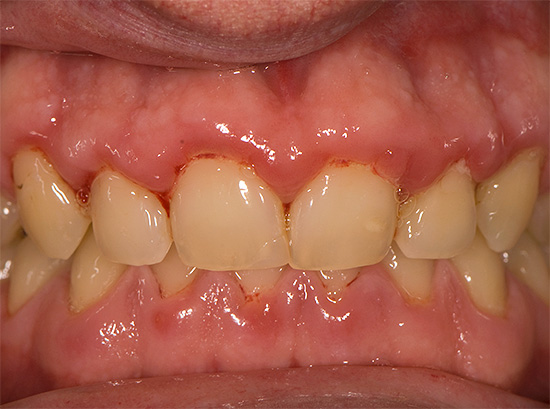
Feedback:
“Recently, I also suffered, in the evening my teeth started to hurt badly, I thought it was caries. Every time the whole evening ached. But it turned out that the problem is not in them, but in the gums. I was prescribed drops by the doctor for the gums, so I diluted them and rinsed them for a week, immediately it became better ... ”
Oksana, St. Petersburg
Mechanism for relieving pain during rinsing
From the above, it becomes clear how mouth rinsing can alleviate the condition of a sick tooth:
- If you rinse your mouth, it will contribute to the leaching of irritating food debris and putrefactive bacteria from the carious cavity, which often eliminates toothache in the shortest possible time (provided that the reason was precisely these most irritating debris). By the way, after rinsing your mouth, it is useful to simply plug the deep carious cavity for a while with a piece of cotton, so that when you eat, it doesn’t eat the remnants of food again and does not cause severe pain.
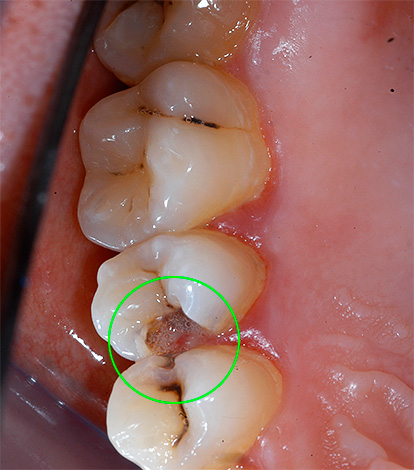
- When pulpitis and periodontitis, when there is an inflammatory process, rinsing the patient's tooth is also able to ease the pain, although usually the effect occurs rather slowly and is not always strongly pronounced. Rinsing the mouth in this case will be useful to increase blood flow to the site of inflammation and, consequently, accelerated removal of toxins and tissue breakdown products from it.If the carious cavity in the diseased tooth communicates with the pulp chamber, then such rinsing will further contribute to the outflow of pus from it.

As previously noted, "toothache" can be caused by inflammation of the gums, and not tooth decay due to caries. That is, a person may feel that he has a toothache, but in fact there is inflammation of the gums, for example, due to the accumulation of food debris in the so-called gingival pocket (in the place where the gums fit the tooth).
In the course of their vital activity, bacteria that actively proliferate here can not only lead to gum inflammation, but also affect hard tooth tissues - for example, cause tooth decay, although the crown part will seem completely healthy.
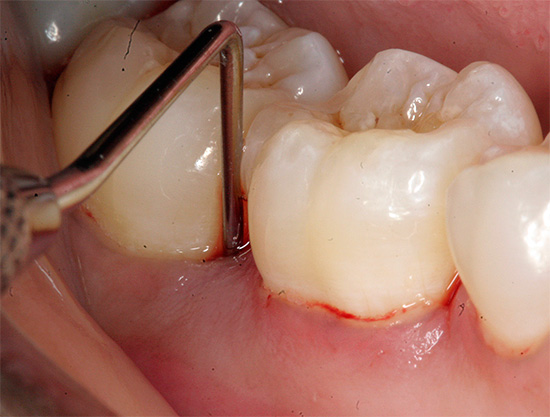
In all such cases, rinsing the mouth also has a very positive effect, helping to remove food debris and bacteria from the gum pockets.
Feedback
“... A good medicine for rinsing the mouth is Listerin, it helps me a lot with toothache. Special such a solution, it is also prescribed by dentists to those with weak tooth enamel.When a tooth hurts, I do this: after eating, I brush my teeth, then I rinse my mouth, first with plain water, and then with Listerine. And that's all, after this gum solution, a little tingles and the toothache calms down. ”
Ivan, Volgograd
However, still, toothache is much more often the result of caries or pulpitis - these are the cases we will further discuss in more detail. Moreover, in order to achieve a positive effect, it is important not only to know what exactly is better to rinse the aching tooth, but also how to do it correctly so that the effect is maximum.
Effective Rinse Rules
Eliminating toothache by rinsing the mouth, you should consider a number of important rules, the observance of which will allow you to get the desired effect and at the same time do not harm your health.
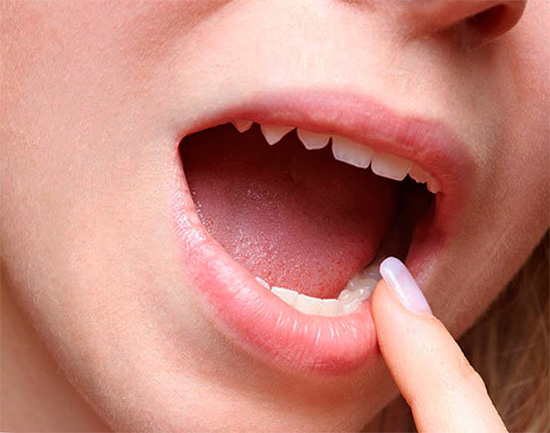
These are simple rules:
- Do not rinse your mouth with too hot solution. The optimum temperature is 37-45 ° С, but not higher. Fans to rinse a sick tooth with hot broths can not only burn the mucous membranes of the mouth, but also burn the pulp inside a completely live tooth, which will subsequently lead to its necrosis.
- The more rinses occur, the better. In the ideal case, a bad tooth and gum should be regularly washed with a fresh solution.In practice, in most cases, it is enough to rinse your mouth once an hour or two for about 15-20 minutes per procedure.
- You can not warm a sore tooth outside - for example, a heating pad, or clinging to the stove or radiator (there were such cases). This cheek can swell very much. Also, do not sleep on the side of the face where the aching tooth is located.

Such recommendations are usually given by dentists to their patients, who ask for advice by telephone in order to reach the treatment itself (well, unless they can additionally recommend pain relievers for toothache). At the same time, the stronger the tooth hurts and the more pronounced the inflammation, the more usually the patient is more determined than ever and quickly get rid of his problem - so in this case it is important not to go to extremes and not to forget about common sense (do not warm the solution for rinsing to a boil in the hope that the hotter it is and the harder it is for them to rinse, the more useful it is, not to soar the swollen cheek in the bath, expelling the “hated ailment” with a broom, etc.).
On a note
Sometimes you can hear that “hot” mouth rinses are recommended to remove pus from purulent pockets - so, this does not mean that you need to pour boiling water into your mouth.We are talking about solutions and decoctions having a temperature of about 45 ° C. In any case, the rinsing solution should not burn or cause severe pain: if you have pulpitis and a solution with a temperature of 45 ° C causes a sharp increase in pain, then you do not need to torture yourself - rinse the aching tooth with a solution of 36-37 degrees.
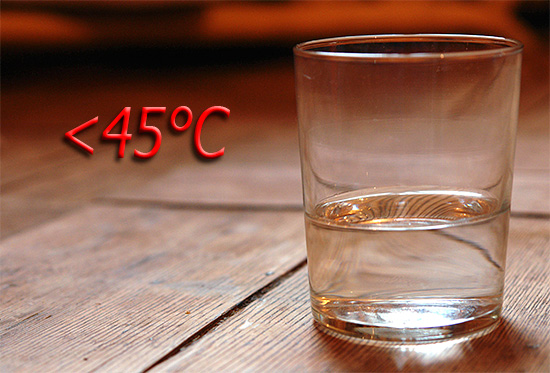
In most cases, the most effective rinsing of a sick tooth is as follows:
- A warm rinse solution is collected in the container - about a liter or one and a half;
- Preparing an empty basin, if rinsing will not be carried out over the sink;
- About half a full sip of the solution is taken in the mouth, and within 20-30 seconds the mouth cavity is thoroughly rinsed. Moreover, it is necessary to do this in such a way that it is the diseased tooth that is irrigated with the solution especially intensively.
- After the mixture has been rinsed, the solution spits into a basin, then a new batch is collected and the process repeats. And so to the exhaustion of all the prepared solution, which should take about 15-20 minutes. After a couple of hours, the whole procedure can be repeated.
Important!
But if you have a tooth removed and your gums ache (after the anesthesia has passed), then you should be very careful with mouth rinses.It is important not to damage the protective blood clot that has formed in the tooth hole and reliably protects it from infection. Many maxillofacial surgeons generally do not recommend rinsing the mouth on the first day after tooth extraction. On the second and subsequent days, active rinsing is also not acceptable, but neat mouth baths are quite suitable - they put a solution into their mouths, hold it at the sore spot and spit it out.

Than to rinse: we select the most effective solution
It may seem strange, but the composition of the solution for rinsing a patient's tooth is, by and large, secondary, much more important is how the procedure is performed. If the procedure is carried out correctly, then the maximum effect can be achieved with simple warm water.
However, individual additives can increase the effectiveness of the measures taken:
- Salt or soda - they are added in the amount of one teaspoon per glass of water (it can be limited to only salt). Such a hypertonic solution provides the removal of pus from the site of inflammation,and elevated solution temperature promotes blood flow to the affected area.

- Chamomile, which has anti-inflammatory and antimicrobial action. From it simply make a decoction, pour two tablespoons of dried flowers with a liter of boiling water, allow the solution to cool to the desired temperature, filter and then rinse.
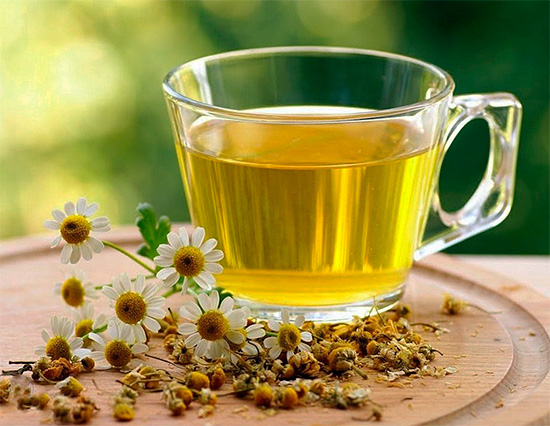
- Sage, whose properties are quite close to the properties of chamomile. We can say that rinsing the mouth with a decoction of sage is a classic, and many dentists often recommend this option. Gargling with sage is carried out in the same way as gargling with chamomile decoction, and the broth is prepared according to the same recipe, with the only difference being that sage leaves are taken instead of chamomile.
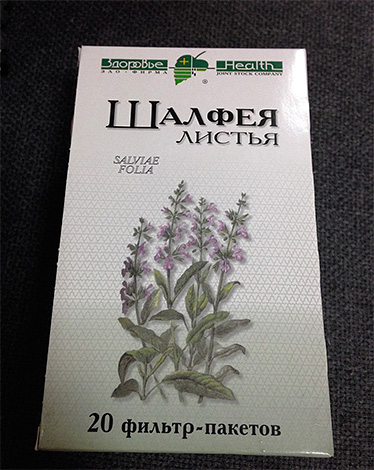
- Also worth mentioning is the oak bark, known for its anti-bacterial and anti-inflammatory properties.

In cases when all these products are not available, rinse your mouth with plain warm water or even tea (without sugar). It is only important that the liquid is not cold.
What is NOT recommended to rinse your mouth with toothache:
- Hydrogen peroxide - so short to earn a chemical burn of the mucous membranes of the mouth; moreover, if the carious cavity has a message with a pulp chamber,then the hydrogen peroxide solution can flow into this chamber and begin to decompose in it with the release of oxygen bubbles. A sharp increase in pressure in the pulp chamber can cause a significant increase in pain;
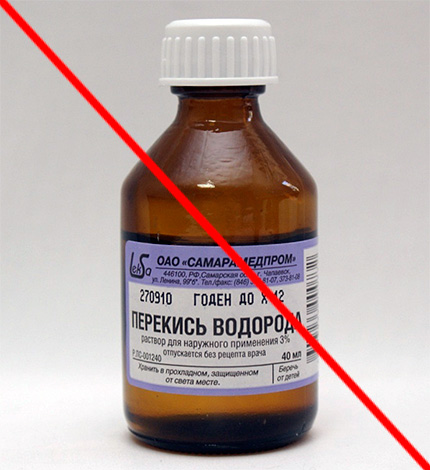
- A strong solution of potassium permanganate can also cause burns (if you already want to rinse with potassium permanganate, use a 0.1% faint pink solution);

- Gasoline and kerosene - no effect (except for health hazards) such rinsing will not give;
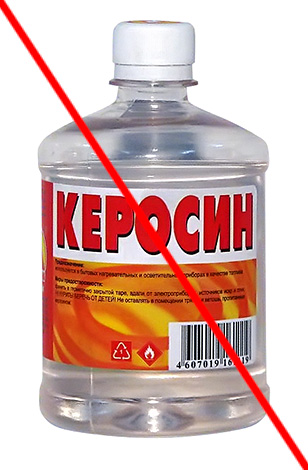
- With alcohol - yes, it is a good antiseptic, but at the same time it has a burning effect on soft tissues. With prolonged contact with a tooth that has a deep carious cavity, ethanol can diffuse into the pulp chamber and lead to pulp necrosis.
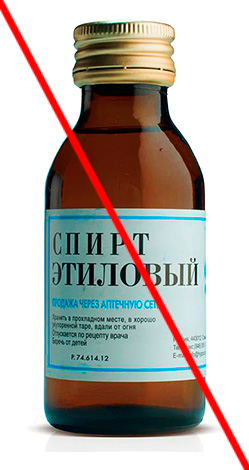
Feedback
“Rinsing with salt personally personally saved me from a toothache, I don’t even have to drink pills. When I feel that I ache, I pour a third of a tablespoon of table salt into a glass of hot water, mix it up, rinse my mouth and everything passes. It is clear that this works only if you take care of your teeth. My sister brought the whole thing to inflammation, then went with the cheek to the shoulder ... "
Veronica, Orenburg
When rinsing does not help for toothache
It is important to understand that rinsing the mouth does not allow to cure a sick tooth: the enamel eaten by caries will not increase from this, and the half-dead pulp will not come to life. Such rinsing relieve pain only for a short time, so that as soon as possible you need to see a dentist.
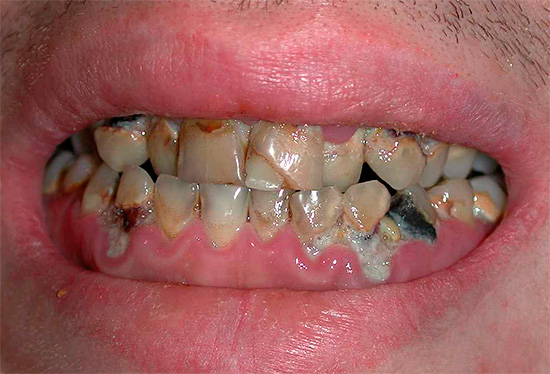
In some cases, rinsing helps poorly or does not help at all - a lot depends on the physiological characteristics of the person and the specific pathology that led to the appearance of toothache.
Sometimes rinsing the mouth can even hurt, especially if one does not rush to see a doctor. For example, in the case of difficulty in the eruption of a wisdom tooth, severe inflammation of the surrounding gingival tissues can occur, and warm, but not always correctly performed mouth rinses can in rare cases only aggravate the inflammatory process.
Anyway, trying to rinse off toothache just to avoid going to the doctor can be very dangerous. So use this technique wisely and only as a temporary saving measure.
If you have already had a chance to relieve toothache by rinsing your mouth, be sure to leave your review at the bottom of this page: how were you rinsed, did it help, and if so,then how fast? ..
Useful video about methods of relieving toothache at home without the use of pills
Extreme way to relieve toothache with garlic (not recommended)


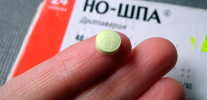
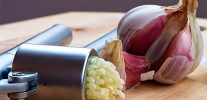
My baby tooth hurts, I loosen it, but it never passes.
Every half hour, 3 teeth start to hurt at the same time.I tried everything, but it does not help. Now I poured a glass of alcohol and diluted it with warm water. It seems to help ...
Once I was told that I have a strong periodontitis and that the tooth needs to be removed. But I didn’t agree and treated him.) I rinsed: for 200 grams of warm water 1 teaspoon of soda and salt, plus 2-3 drops of iodine. Yes, yes, it was with this that I cured my tooth! )
Immediately after removal, it is better not to rinse, doctors do not advise. You can apply the ointment, gels. We sister smeared parodontotsid gel, to remove inflammation. Again, if a tooth aches because of the gums, you can rinse it, but if the tooth itself hurts, then you should not rinse, but go to the doctor.
My teeth hurt all at once. She made a tablespoon of sage into a glass of boiling water. Just be sure to allow the solution to cool to body temperature. After the first rinse, everything vanished.
I rinse the tooth with salt. Helps a lot.
He suffered with a tooth, re-read all types of rinses and compresses, half did not help, and on one site I read about peroxide, only it must be diluted with water.But since I got a tooth to such an extent that patience is exhausted, I dripped concentrated, it became sick 2 times stronger than about 3 hours, and now almost a year does not bother. Looks like the nerve finally burned)) Now I think to remove and insert a new one. I do not advise you to do so, I have experienced it in my own way, it was just an extreme measure, in which case everyone would be at risk when he could not go to the clinic.
After my tooth extraction, my gum was very sore. Then rinsing with periodontal disease helped. This remedy, I bought in a pharmacy. Based on herbal ingredients (oils and extracts of sage, mint and cloves). I rinsed twice a day, but more often.
Miramistinas a sick tooth, did not help ... I watched a video about garlic - and lo and behold! After 10 minutes, the pain passed, even with joy I was able to eat)) But I didn’t grind, but cut off a piece and put it on the aching tooth, pressing garlic. I didn’t experience any pain as it was said in the video. Toothache, apparently, was stronger ...
Salt solution helped: 1 teaspoon of salt to 1 liter of warm water.And tomorrow urgently to the doctor))
Alcohol is really better not to rinse. I had a toothache, like with pulpitis (I know, because the nerve was repeatedly removed from the teeth). A friend advised quite strong pain pills. Well, I drank them for 3 days, it really helped - for 6-7 hours the pain was gone. Then he got tired and decided to try the good old method - to rinse the tooth with alcohol. And somewhere in half an hour I felt that my gums had started to swell, and not near the patient's tooth, but near the next one. I went for a week - the acute toothache was gone, but the gums started swelling almost throughout the lower left oral cavity and cheek. Now I’ll have to go to the doctor for anyone, but now, I think, it would be better to have a toothache, or I would immediately go to the dentist, or rinse with some soda. Because, most likely, something more serious picked up than a simple pulpitis. So once again advice (suddenly someone will come in handy): do not rinse with alcohol. Maybe it will help, but once in a while it is necessary.
Rinse with chamomile and oak bark, supposedly feel better - until you get bored, and you still need to get a doctor.
I dissolved a teaspoon of soda (without a slide) in half a glass of water at room temperature, rinsed my mouth, focusing on a bad tooth. After 20 minutes, the pain did not go away, but subsided by 70%.
Rinsing with soda and hot water (45 degrees) helps very well with flux, so the pus is washed out. I advise everyone. And in the queue to the dentist, the people also share this remedy. But! A dentist should definitely be contacted, now the progress has gone far. Not like in the 90s, scary to remember!
Vodka with red pepper helped me, even when the ketans did not help, but shpa and other painkillers with solutions of salt and soda. This is all garbage with a strong shooting pain, when you think you will go crazy. Vodka with red pepper always helps me, sometimes just vodka.